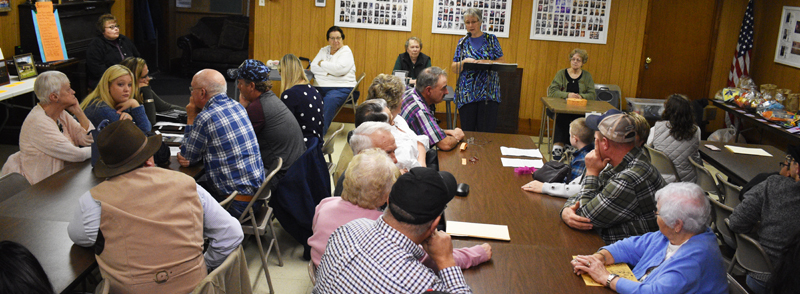
Local historian Betty Calhoun served as the emcee for the Ag Heritage Night held at the American Legion hall in Dayton last Saturday, October 12. It was sponsored by the Marshall House in celebration of their 150th anniversary.
The Marshall House in Dayton continued celebrating their 150th anniversary with an Agricultural Heritage Night last Saturday.
The event honored owners of the local area farms that have been in existence for more than 100 years and are listed with the State as “Century Farms.” Displays showed photos of different farms, and highlighted the Dayton Fair, Dayton Grange, and various types of agriculture produced by the farms.
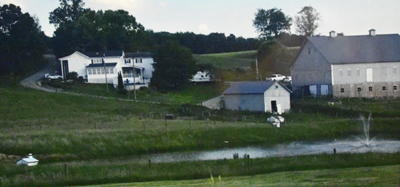
The Ellenberger Farm
ELLENBERGER FARM - The first farm to be honored was the Ellenberger family. Jim and Wanda Ellenberger were represented by daughter Danielle and Donald. Danielle explained that her children, children Madison and Mariah, are the sixth generation to be raised on the farm, which began in 1864. The first barn burnt down and the current barn was built in 1903. The farm had a smoke house, a coal house, a chicken coop, a garage, a wagon shed, a barn, spring house, and the main residence. The wagon shed, the barn, and residence are still standing today. The residence got plumbing in 1949. It had coal heat until 1966 when they got natural gas. It had a 10-party telephone line in the 1950s.
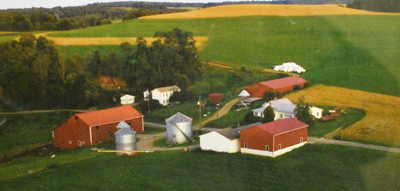
The Houser Farm
HOUSER FARM - Don Houser gave information about the Houser Farm, which was originally purchased in 1867. Don’s grandfather was born on the farm in 1900 in the original farm house that is still standing, and moved to the current house Don and his wife now occupy when he was several years old. A natural gas lease was originally signed on June 19, 1899 and the gas well was drilled on the farm in 1901 that supplied heat to the residence. The well was re-drilled in the late 1990s and Don reported it is making more gas now that previously. The original barn is still there and has been added onto several times throughout the years. The cement work where cows are still milked is dated November 1937. There is a stone fence of several hundred feet that was built by Don’s grandfather while he was letting the horses rest. In the 1950s, the grandfather bought another 100 acres. He had to use a dozer to plow 50 feet, then stop to chop the tree roots with an ax. The first tractor was an Allis Chalmers purchased in the 1940s; then later a John Deere, followed by a combiner and bailer in the 1950s. The farm today is over 400 acres. The grow corn, soybean, oats, and hay. They milk 42 cows with approximately 40 more young cattle. When the farm was transferred in 1929 to Don’s father, the grandfather stipulated in the deed that his son must supply his parents with farm products with flour, butter, beef, etc.
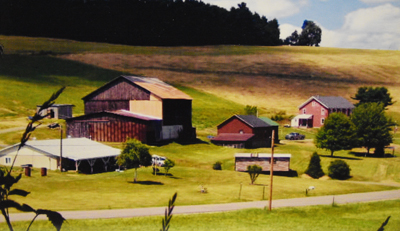
The Reesman Farm
REESMAN FARM - Nelson Reesman was not present at the event, but supplied information about his farm, which was originally purchased by John Reesman. His family was one of the first settlers in Wayne Township. His post office was in Kittanning. He would walk 16 miles once each week to check his mail. John purchased 500 acres on August 8, 1847 for $579.50 from the North American Land Company. John built the red brick house by himself, wheeling brick for over a quarter-mile. The walls are 14 inches thick with iron rods running corner to corner. The second floor and first floor are divided into four equal rooms with fireplaces in each room. The barn is original and the first water supply was a hand-dug well. The property later changed hands to John’s son, George Washington Reesman; then later to George’s nephew, also named George Washington Reesman. The nephew then sold it to his father, Charles Reesman. Transfer of the property then went to Ivan Reesman, Paul Reesman, and finally to Nelson. The families were general farmers with a large variety of livestock and crops. All of the decendants have lived in the red brick house, except for Nelson. The back end of the property was stripped for coal in the early 1940s. Nelson makes hay off of that portion of the property. The Reesman one-room school originally stood at the crossroads of several dirt roads on the property and was used from early 1900s through the 1940s. Nelson’s grandfather, Ivan - or Ikey as he was called - bought a new farm Ford tractor in 1954, which is still on the farm. Nelson works off the farm as a mechanic, but does the farming. Nelson’s children are part of 4H and have sheep and goats. Nelson remarked that he is proud to have a close knit family still working on the homestead land that has been in the family for the past 171 years.
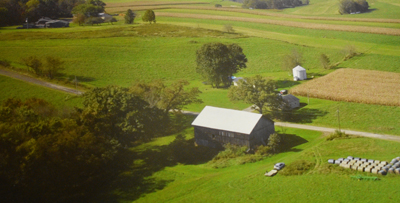
The Buzzard Farm
BUZZARD FARM - The original owner was Samuel Good (originally spelled “Guth”), born March 31, 1807 and died March 21, 1896. He moved from Blair County in 1840 to Smicksburg area, buying five farms in both Indiana and Armstrong counties, of approximately 1,000 acres. Good, along with Henry Goss, bought 149 acres in Wayne Township from William Glenn. Good bought Goss’ interest upon his death in 1880. Good’s youngest son, William, was born June 18, 1854 and died September 25, 1878. William’s only son, Harry, was born August 20, 1877 and died Feb 15, 1950. Harry bought 100 of the original 149 acres in 1895 from Samuel, his grandfather, for $2,000. Fourth generation descendant Harry Buzzard, grandson of Harry Good, bought the 100 acres from Harry Good in 1949. In 1950, they had electric in the house and water was pumped from a windmill into a cistern on the hill above the house for gravity flow. They ran a dairy farm until 1964; then raised beef cattle until 1983, then shifting to raising grain. Harry Buzzard died in 2010. His daughter, Bonnie and husband Gary, lives on the present farm now with her grandchildren. Son Harry owns 92 acres, Bonnie owns six acres with a residence that was built in 1979. Kevin and Bonnie owns two acres and built their home in 1999. Son Harry farms the hay and the grain. The original house and barn was built in 1895. Lightning struck and hit the house and destroyed it by fire on July 3, 1975. The original barn is still standing. The remaining 92 acres was gifted to Bonnie in 2016 by her mother.
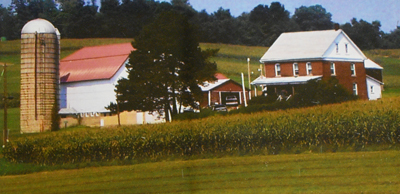
The McIntire Farm
McINTIRE FARM - This farm is located about three miles west of Dayton. Daniel McIntire was the original owner. He and his family moved from Westmoreland County to Wayne Township to a farm two miles west of Echo, approximately six miles from the current farm. A few years later, Daniel married Martha Lias, whose father, Peter, was the homestead owner of the McIntire Century Farm. The farm came up for sale at auction and Daniel McIntire bought the farm $2,161 in 1889. The 114-acre farm is bordered by two farms owned by Tom and Jeannie Grooms. Daniel farmed the farm for about four years, then died in 1893. His son, John Wesley McIntire, took over the farm and was known for having a fine herd of Jersey registered cows. The present farm house was built by John McIntire, who hired a man to build it in 1912. It had an electric generator in the basement that would run to charge up a series of batteries used for lights in the house. Before then, Daniel and John and families lived in a log house on the farm. It was later converted to a stable for pigs and chickens and torn down in the 1960s. In 1933, the farm was passed on to Herbert McIntire. Herbert sold the Jersey cows and began raising registered Holstein cows and other animals. In 1941, Herbert had the original barn torn down and erected a larger barn. The Mahoning Dam was being built and the barn was moved from its original location in Milton to the McIntire Farm. It had to be dismantled, moved, and reconstructed. It featured hand-hewn logs that were so long, they had to be placed on the sides of the flat bed truck and stuck out over the front of the bumpers. Once the load was so heavy the truck could not be steered going up a hill because of the weight, and Herbert had a helper crawl out on one of the logs and sat on it to provide more weight to the front of the truck. In 1943, an electric milking machine was purchased along with the first tractor, a Farmall H, which is still on the farm today. In the 1960s, an indoor bathroom was installed. In 1970, Wayne McIntire bought the farm from his father, Herbert, and he continued farming and milking Holstein cows. In 1987, Wayne sold the cows, going into semi-retirement and just raised crops for resale. In 2005, Wayne’s son Bob had retired from teaching school and bought the farm and continued to raise hay, wheat, oats and corn. They live in the same house his great-grandfather built over 100 years ago. Bob praised his brother, Gary, his children, and other relatives for helping to keep the farm operating in the present day.
There were other Century Farms but owners were not present or did not provide a display of their farm.
Local Historian Betty Calhoun served as the emcee for the event. She also gave background on the Marshall House & Museum located at 109 North State Street.
“The original owners Tom and Rosetta were married in 1850. The family operated a general store in Dayton. Tom wanted to give his wife gravity flow water. In the attic, there is a large wooden barrel that is 53 inches tall and 65 inches across and it holds three tons of water. They would turn on a windmill and fill up as much water as they wanted in it. If it overflowed, there was a pipe outside that would catch the overflow. When ladies in the kitchen heard water hitting the trough outside, they knew the windmill needed to be turned off. The house was going to be torn down in 1976. The town knew how much the Marshalls had done for the community - he contributed to the progress of the community in the area of business, finance, agriculture, husbandry, education, government, and religion - so they wanted to save the house. The government offered money to restore it for the bicentennial year. A committee was formed and with the help of the community, the house was restored. It is now a national historical landmark.”
For more information on the Marshall House, call 814-257-8846.
